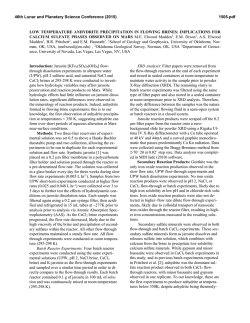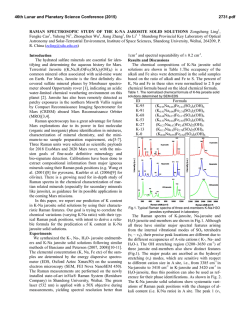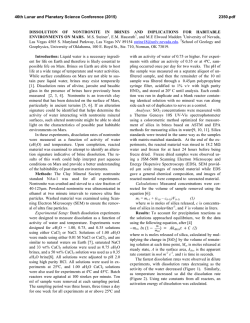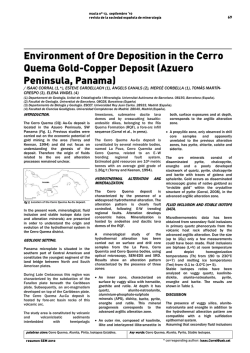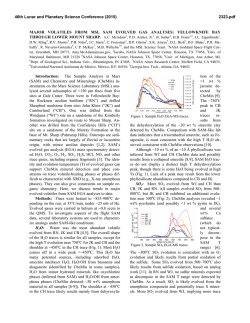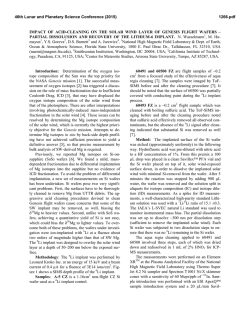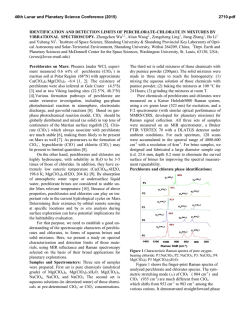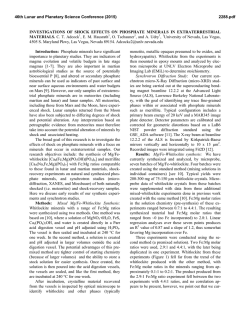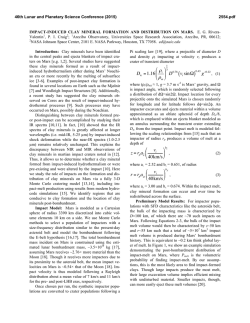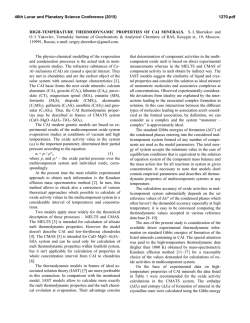
FLUID ALTERATION OF ALUNITE GROUP MINERALS
46th Lunar and Planetary Science Conference (2015) 1513.pdf FLUID ALTERATION OF ALUNITE GROUP MINERALS: COMPARING DISSOLUTION RATES AND PRODUCTS M.E. Elwood Madden1, A.S. Elwood Madden1, J.M. Miller1, C.M. Phillips-Lander1, and B.R.Pritchett2, 1School of Geology and Geophysics, University of Oklahoma, Norman, OK, USA, ([email protected]) , 2Oklahoma Geological Survey, Norman, OK, USA Introduction: Alunite supergroup minerals (AB3(SO4)2(OH)6) including jarosite (A= Na, K, or H; B= Fe) and alunite (A= Na or K; B= Al) are common phases found in terrestrial fumaroles [1], hydrothermal systems [2], sulfuric acid caves [3], acidic hypersaline lakes [4-5], streams and lakes affected by acid rock drainage [6], and acid sulfate soils [7]. Sulfates, including jarosite and alunite, have also been observed using spectrometers orbiting Mars [8-9] . This study investigates alunite supergroup dissolution mechanisms by examining A- and B-site cation release rates, as well as reaction products, under varying environmental conditions. Results will inform models of mineral-water interactions on Earth and Mars, providing fundamental scientific support to understand the implications of mineral and solution chemistry on the conditions that favor preservation of alunite and/or jarosite, along with estimates for the lifetimes of active aqueous diagenesis. Methods: Jarosite and alunite were synthesized [10-11] in the lab and materials were characterized using electron microprobe, powder XRD, BET surface area analysis, and TEM. 100-250 mL batch reactor experiments were conducted in triplicate with 1g mineral/L solution. Batch experiments were conducted in ultrapure water (UPW, unbuffered experimental pH 35 following contact with minerals), pH 2 sulfuric acid, hydroxide-buffered pH 6-10 solutions, as well as saturated NaCl and CaCl2 brines. Mineral-solution slurries were sampled and filtered at pre-determined intervals, then refrigerated prior to Atomic Absorption Spectroscopy analysis. Dissolution in Dilute Solutions: Alunite dissolution is 2-3 orders of magnitude slower than K- or Najarosite dissolution rates in dilute solutions over a wide range of pH conditions. However, Na- and K-jarosite dissolve at generally equal rates under a wide range of solution conditions [12-13]. This suggests that B-site substitutions have significant effects on dissolution rates, while A-site substitutions in jarosite do not affect dissolution rates. We hypothesize that slower alunite dissolution may reflect slower water exchange rates with Al3+ compared with Fe3+. Alunite, K-jarosite, and Na-jarosite dissolution rates all exhibit a V-shaped trend with varying pH, indicating two or more dissolution mechanisms. At lower pH, dissolution rates increase with increasing [H+], while at higher pH, dissolution rates increase with increasing [OH-]. However, the pH at which this inflection occurs differs between alunite and jarosite, also suggesting that B-site (Fe or Al) hydrolysis and hydration rates are a primary determinant of dissolution rates. Dissolution in Brines: Initial dissolution rates for both alunite and jarosite decrease as the activity of water decreases in saturated NaCl and CaCl2 brines. While jarosite dissolution rates are significantly faster in dilute solutions, jarosite and alunite dissolution rates converge as the activity of water decreases and chloride activity increases. This observation further supports the role of the Bsite cation in dissolution rates. Differing water exchange rates between Fe and Al at the mineral surface may control dissolution rates in dilute aqueous systems. In contrast, chloride complexation with Fe and Al occurs at similar rates. However, over time alunite and jarosite dissolution rates both accelerate in CaCl2 brine [14]. Gypsum formation was observed with XRD in both alunite and jarosite CaCl2 brine experiments. Increased chloride complexation with B-site cations likely leads to increased dissolution rates with time, especially when cations are precipitated as sulfates. Incongruent Dissolution: Experiments at pH 3-5 in UPW, and brines all produce non-stochiometric solute concentrations indicating incongruent dissolution and/or rapid precipitation of reaction products. Jarosite dissolution is highly incongruent in UPW due to iron oxide precipitation. Fe3+ is less soluble than Al3+, resulting in lower B/A site cation ratios in jarosite experiments compared to alunite. In TEM analyses, abundant iron oxide reaction products were observed as a result of jarosite dissolution. In contrast no crystalline aluminum oxides were observed in alunite dissolution experiments, even after >2 weeks of dissolution. Experiments in pH 2 sulfuric acid yielded the highest B/A-site cation ratios. This is likely due to higher Fe3+ and Al3+ solubility with limited hydrolysis at low pH. B/A-site cation ratios increased with time for both minerals in NaCl and CaCl2 brines, likely due to increased chloride complexation as sulfate minerals precipitate. Hydrothermal Alteration: While jarosite dissolution rates increase with temperature following Arhenius trends, no clear trend is observed in alunite dissolution rates as temperature increases to moderate hydrothermal conditions. This may be due to decreased 46th Lunar and Planetary Science Conference (2015) alunite solubility at moderate to high temperatures. While jarosite solubility remains relatively constant over the range of temperatures investigated, alunite is less thermodynamically stable at low temperatures, resulting in higher solubility. Therefore, the thermodynamic driver for alunite dissolution decreases as temperature increases and alunite becomes more stable relative to jarosite. This may result in slower alunite dissolution rates, despite higher temperatures. Implications for Mars: Alunite is more likely to be preserved in neutral to moderately alkaline systems compared to jarosite, which is expected to be preserved in more acidic conditions. While jarosite particle lifetimes are relatively short at high temperatures due to increasing dissolution rates, alunite dissolution rates do not increase at higher temperatures. Therefore, alunite may be more prevalent than jarosite in hydrothermally altered deposits. Finally, because alunite dissolution rates are comparable to jarosite dissolution rates in high salinity chloride brines, no difference in preservation is expected in systems containing high concentrations of chloride salts. While spectral data suggest numerous occurances of hydrated sulfate minerals on Mars, jarosite and alunite are diffficult to discern from orbit due to likely solid solution. However, in situ identification of jarosite or alunite via XRD and/or compositional data may aid in interpreting the aqueous history of sulfatebrearing rocks, including those observed by orbiting spectrometers in Mount Sharp layered deposits within Gale Crater [15]. Areas where jarosite is predominant may indicate a history of lower pH or lower temperature environments. Also, jarosite dominant areas may indicate a period of shorter water duration, owing to shorter particle lifetimes in dilute solutions. Areas rich in both alunite and jarosite may indicate a brief duration of water, or presence of low activity brines in which alunite and jarosite dissolve similarly. Areas where alunite is predominant may indicate a history of higher pH or higher temperature environments. Alunite may also survive in areas containing carbonates, which buffer systems to a higher pH. Alternatively, in some areas jarosite may have once occurred with alunite, but extended water duration may lead to jarosite dissolution, while preserving only alunite. Jarosite dissolution at pH >4 produces abundant nanoscale iron oxide minerals, including hematite, goethite, and maghemite. Thus, jarosite dissolution may contribute to abundant nanophase iron oxides observed in global dust deposits [16]. However, alunite dissolution is less likely to form crystalline reaction products and may instead produce amorphous materials also observed in fine grained sediments and dust on 1513.pdf Mars [17]. References: [1] Africano and Bernard (2000) J. Vol. & Geotherm. Res. 97, 475-495. [2] Dill, (2001) Earth Sci. Rev. 53, 35-93. . [3] Plan et al. (2012) Geomorph. 169, 45-54. [4] Alpers et al. (1992) Chem. Geol. 96, 203-226, [5] Bowen et al. (2008) App. Geochem 24, 268. .[6] Nordstrom (2011) App, Geochem. 26, 1777-1791 [7] Bloomfield and Coulter (1973). [8] Glotch and Rogers (2007) JGR 112; [9] Poulet et al., (2014) Icarus, 65-76 [10] Driscoll R. and Leinze R. (2005) U.S.G.S. Tech. & Meth. 05– D1 [11] Brophy (1962) Am. Min. 47,112. [12] Elwood Madden et al. (2012) GCA 91, 306-321 [13] Zahrai et al. (2013) Icarus 223, 438-443 [14] Pritchett et al. (2012) EPSL 357, 327-336. [15] Milliken et al. (2010) GRL 37, L04201. [16] McSween et al. (2010) JGR 115, E00F12 [17] Bish. et al. (2013) Science 341, 6153 Acknowledgements: Funding for this project was provided by NASA grant NNX13AG75G and the School of Geology and Geophysics at the University of Oklahoma.
© Copyright 2026
